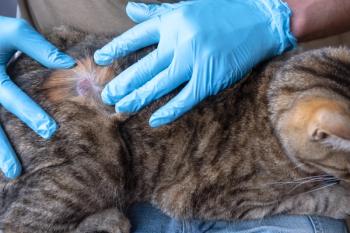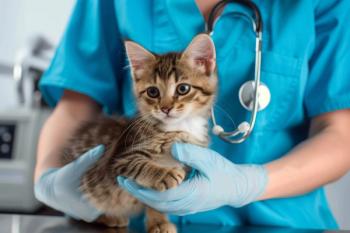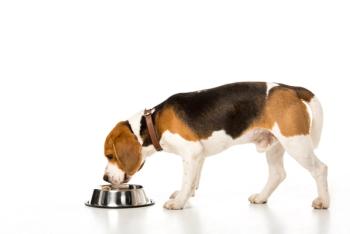
DVM Newsmagazine Survey: Medical delivery evolves as clients, returns develop
National Report - Veterinary practices are trending toward higher-quality medicine that serves higher-quality clients.
Editor's note
Society is truly demanding. As medical delivery evolves, so too do pressures on general veterinary practices to improve standards of care. In turn, as costs escalate, so too do client pressures to keep fees in check. Are we in an age where the cost of equipping a veterinary practice outpaces the cost of building and land? Are the costs needed to run an effective service exceeding your client's means to pay? Conducted every three years, our 2006 State of the Profession Survey and coverage seeks to offer a snapshot of veterinary practice today. The ensuing editorial coverage probes some of the poignant business problems and opportunities faced by veterinarians. Next month's exploratory looks at professional issues will include ethics, euthanasia and achieving a sometimes elusive work/life balance.
Table 1 More veterinarians offer high-quality diagnostics and surgery for clients that don't consider cost a major factor (left) instead of giving clients whatever level of service they request (right).
NATIONAL REPORT — Veterinary practices are trending toward higher-quality medicine that serves higher-quality clients.
Since 1997, more respondents to the DVM Newsmagazine State of the Veterinary Profession Survey (methodology) say they provide high-quality diagnostic medicine and surgery services for clients who tend to base care on need instead of price. In 2006, 31 percent of respondents say they fall into this category, a steady rise since 1997, when just 19 percent of DVMs noted this type of practice (Table 1). Conversely, those who report accepting all paying clients and perform whatever level of care their clients request dropped steadily from 74 percent in 1997 to 64 percent in 2006.
Table 2 Diagnostics, surgery challenge annual exams and vaccines as revenue streams.
The increasing reliance on diagnostics and surgery translates into a greater share of revenue than in years past as well. Although annual exams and vaccinations combined are still the leading source of revenues for most generalists, diagnostics and surgery combined are expected to constitute 40 percent in three years, veterinarians report (Table 2).
The trend might help offset diminishing returns on vaccines, biologicals and some other products. Mark-ups on vaccines and biologicals have declined steadily from 373 percent in 1997 to 143 percent in 2006 (Table 3).
Table 3 Pharmaceutical, vaccine mark-ups slide; pet foods climb.
Practitioners increasingly separate their exam fees from vaccine charges. Three-quarters of all respondents now break out their exam fee from vaccinations; about half did so in 1997 (Table 4).
Table 4 Practitioners increasingly separate vaccination charges from the physical examination.
In the face of dwindling product mark-ups, veterinarians perceive increasing business pressure from Internet-based suppliers as well. Ranking as the most frequently cited concern, 62 percent of respondents say Web sales pose competitive business pressure (Table 5). About one-quarter of all respondents say they represent the most significant competitive challenge to their practice.
Table 5 Competitive business pressures
Traditional veterinary clinics remain the most competitive threat (related story). Almost 36 percent claim they have at least five competitors within five miles of their practice. About 46 percent report having two, three or four competitors within five miles; about 18 percent have one or two competitors. No significant differences were observed in results from years past.
About 17 percent of respondents say corporate veterinary practices associated with pet superstores are a competitive concern, but just 5 percent say they are the most-significant challenge to their practices. Moreover, negative sentiment toward corporate practices continues to soften. Just 19 percent say they are strongly opposed to corporate clinics for the profession compared to 29 percent in 1997 (Table 6). Almost 50 percent say they are either neutral or in favor or corporate practices for the profession in 2006. Only 30 percent shared that sentiment in 1997.
Table 6 Sentiment toward corporate practices has softened in recent years.
But it remains a struggle to keep up with the Joneses, especially for lesser-grossing practices. About a quarter of practitioners who gross less than $250,000 say their facilities and equipment are worse than practices down the road, and less than 20 percent say their infrastructure is better. This group was more confident in their facilities and equipment in 2003. But that uncertainty shrinks proportionately to revenue. About 70 percent of practices that earn more than $1.25 million say their equipment and facilities are superior to their competitors' (Table 7).
Clients could be picking up on that confidence. Of the respondents that report a significant drop in active clients (more than 15 percent), more than 61 percent grossed less then $500,000. About 44 percent of practices that gross less than $500,000 had 1,200 active clients or less; 28 percent had 1,201 to 2,000, and 14 percent had 2,001 to 3,000 clients.
Table 7 Confidence in equipment and facilities increases in proportion to gross revenues.
Of practices that gross $500,000 to $1 million, 9 percent had less than 1,200 active clients; 24 percent serve 1,201 to 2,000; 24 percent see 2,001 to 3,000 patients each year; 26 percent serve 3,001 to 5,000 patients, and 16 percent see more than 5,000 patients each year.
About 91 percent of all respondents say they are seeing either the same number or more clients than they did in 2003.
Maintaining margins?
The average client transaction (ACT) for the average respondent rose to $106 in 2006 compared to $98 in 2003; that's about a 2.75-percent increase compounded annually. The change in the Consumer Price Index (CPI) — commonly referred to as the rate of inflation — was 2.3 percent in 2003, 2.7 percent in 2004 and 3.4 percent in 2005, according to the U.S. Department of Labor Bureau of Labor Statistics. CPI for 2006 is already 1.9 percent through April, and many analysts — as well as the federal government — fully expect inflation to topple 5 percent come year end (related story).
But most larger practices show larger ACTs. Almost half of practices with at least four DVMs garner at least $120 per patient visit. Although only 6.6 percent of respondents report ACT lower than $70, 80 percent of those respondents are solo practitioners. About 31 percent of all practitioners earn $70 to $99 per patient visit; about 31 percent report $100-$119 ACTs, and 31 percent say they bring in $120 or more per patient visit.
More than 56 percent of practices that gross less than $500,000 report ACT less than $100. Just 16 percent of practices that gross less than $500,000 have an ACT of $120 or higher.
In practices that gross $500,000 to $1 million, 37 percent have an ACT lower than $100, and 23 percent report an ACT of $120 or more.
About 45 percent of practices that gross more than $1 million generate $120 or more for each visit; about 23 percent report an ACT below $100.
Practice revenues appear to reflect the higher transactions. The average practice generates more than $925,000 each year, up from $714,000 in 2003 and $664,000 in 2000. Similar to years past, about two-thirds of respondents report an increase in profits. About 12 percent report a drop in net revenues, and 23 percent reported no change.
But almost three-quarters of veterinarians are optimistic about the future: 72 percent expect higher practice revenues next year while 24 percent expect about the same. That means just 4 percent expect their revenues to drop.
About 25 percent of respondents generate less than $500,000. About 30 percent of practices earn $500,000 to $1 million, and 42 percent of respondents say their practices earned at least $1 million in 2005, up significantly from the 27 percent who reported breaking the million-dollar barrier in fiscal year 2002. Of those 42 percent highest earners, about one-third generated more than $1.75 million.
Local economies might be playing a part. For the first time in 2006, veterinarians were asked how respective local economies affected business. About 41 percent say the local economy positively affected their business, while 22 percent say their local economies had a negative impact on their practice revenue. Interestingly, 30 percent were not sure how the local economy influenced their practices, and 7 percent reported that the local economy did not influence revenue.
Personal salaries appear to be following the success of the business. Average veterinarian gross compensation rose to about $85,000 in 2005, up from the about $82,000 reported in DVM Newsmagazine's 2004 Gender Shift Survey and special report.
Similar to those results (reported in October 2004 through December 2004) Men are earning significantly more than their female counterparts. Men earned more than $99,000 in 2005 compared to almost $67,000 for women. In fiscal year 2003, respondents averaged about $93,300 and $65,300, respectively.
But almost 28 percent say it's not enough, reporting money as their No. 1 professional life concern. (In July, DVM Newsmagazine will explore work/life balance; 42 percent of respondents say it's their No. 1 professional life concern.)
Newsletter
From exam room tips to practice management insights, get trusted veterinary news delivered straight to your inbox—subscribe to dvm360.





